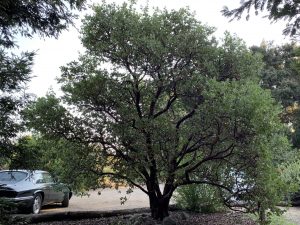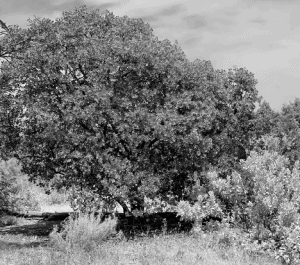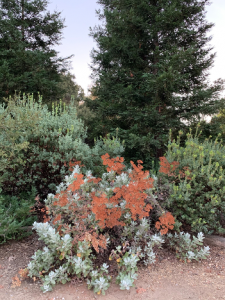To be fair, our title for September as a season called “Pre-Fall” should really be changed to “Post-Summer.” Fall may start in October, but summer’s effects do not end in August. As our planet and our region are growing palpably hotter and drier, and since a long rainless period each year is the main determining factor in what is called a “Mediterranean climate zone” (California is in this category), native plant horticulture is obviously becoming more and more about summer. Now as never before, we have to make sure all our activities in Fall, Winter, and Spring are done right… mainly to get our gardens ready for a long hot Summer.
Current events, history, review, and notes
Let’s see, we have a global pandemic, heat waves that won’t quit, record setting wildfires with unprecedented loss of life and property, (not to mention the ecological impacts on the vast burnt areas), unbreathable air from all the smoke, travel restrictions, public recreational facilities still locked up, and oh yeah, don’t forget a stressful and contentious national election around the corner. Where can we find a little relief?
Enter the natural garden… a miniature representation of wild nature, tended by you and enjoyed by you along with all your fellow mortals (John Muir’s term for wild creatures large and small), giving you great pleasure, promise, satisfaction, hope, and of course the peace and quiet we all need along about now.
Watering
Our cooler nights and shorter days give us a gradual cooling of the soil. This actually makes watering native plants easier and safer, as the potential for root rot and other soil-borne diseases is drastically lessened. Any carefully timed Deep Soak or Refreshing Sprinkle you do in October will feel like an early rain to your plants (only that rainwater is purer). If you’re not familiar with the terms Deep Soak and Refreshing Sprinkle, see our “2020 September in the Natural Garden” and “Watering Native Plants” for a clear description on summer watering.
Always inspect the soil before starting a Deep Soak. You can use a soil probe, or dig a few inspection holes 6” deep in the root zone and open areas of your garden. If the soil is dry at a depth of 4-5” it’s time to water. Charge your soil with moisture in advance of a heat wave (yes, we can still get them this month). Watch the weather forecasts. Garden smart.
Related to Watering
Check your soil surface and microtopography. To get the most from irrigation and rain events, you want your water to slow down, spread out, and soak in. You can achieve this goal by creating swales, mounds, rivlets, basins, berms, and by placing boulders and rock outcrops in strategic spots to keep as much water on your site, preventing run-off and putting it deep in the soil where roots can find it.
Pruning
This is the month you’ve been waiting for to do that artful thinning and shaping of shrubs like manzanita, toyon, rhus, coffeeberry, and subshrubs such as sage, sagebrush, buckwheat, and mallow. If native evergreen trees such as oaks, cypress or bay are looking a little top heavy, or their crowns are too dense and complicated to tell the right story in your mini ecosystem, you can thin them and open them up in October. Deciduous trees and shrubs can be pruned in mid-winter, when they are dormant.
First visualize the effects of your pruning. Study the plant and determine which branches should be completely cut out, others that might be shortened or headed back. Next get your tools ready. Tree saws, loppers, a pole pruner, pruning shears, etc.. Please, no power equipment on the plant itself, OK for cutting firewood on the ground though.
Next, clean your tools… and this is super important. Contaminated tools can spread plant diseases from branch to branch or from plant to plant. (We’re all learning good rules of hygiene in these Covid times). Use a 10% bleach solution (1 part bleach to 9 parts water), rubbing alcohol, or a disinfectant such as Lysol. Dip or spray your shears and thoroughly treat your saws for 8 seconds with each sanitation. While you are pruning, sanitize your tools between every cut if you are cutting diseased wood, and less frequently, but still regularly when pruning healthy wood. If you use bleach, be sure to wash and rinse everything when you finish as it is very caustic and will damage your tools in storage.
Regarding pruning technique, room here does not permit a complete treatment on the subject. In general, go with the “4 d’s” taking out branches that are dead, heading down, or duplicating other branches, first. Then work on the dumb branches, those that don’t make any sense. Now you can start thinning, removing smaller branches that are clogging up interior space, especially in the main crotches and towards the center of the crown.
Make all your cuts at an angle. When removing an entire branch back to the trunk or main branch, do not cut it off flush, nor leave an long unsightly stub. Leave just enough to allow the wound to heal without affecting the main branch. In our dry climate, tree seal or any special paint to treat the pruning wound is not necessary. Call or email me if you have questions on how to remove a large branch so as to not tear the bark off the main trunk when the branch severs and falls.

When pruning, I like to establish a baseline in my mind, determining an average percentage that should be removed, rarely higher than 20 or 30 percent. I go around the whole tree once, main branch by main branch, establishing a rhythm and a consistent pattern. I stand back and view the shrub or tree often, evaluating it from different perspectives. Once I have about finished, I seek out details I have missed. If I think the plant needs more thinning, I start over, branch by branch all around. This phased approach follows the old adage, “You can always take more off, but you can’t put it back on.” To really open up a tree or shrub, imagine a bird flying and flitting through, and perching on the interior branches.
With additional pleasant weather ahead before winter, a lower sun so as to not sunburn the exposed branches, and spring weather to follow, your plant will respond well to artful pruning now.
Weeding
Honestly, your garden should be weed free at this point. You will have eliminated summer weeds a couple months ago and cool season weeds haven’t started yet. Needless to say, if they are a problem, hoe them out or pull them as soon as possible.
Mulching/Top dress
Leave in place the valuable fallen leaves under your evergreen shrubs like manzanita, and under the subshrubs like sage. They make the ideal top dress. If you have bare ground or a brand new garden and you feel you need to apply a layer of organic top dress, October is OK, but if you wait a few weeks you can apply it in the rainy season, which is better. Use 1/2-5/8” chunky ground bark, 1-2” thick. Feel free to apply or refresh a thin layer of mineral top dress (dg, aggregate, pebbles, etc.) anytime.
Feeding
Some people believe native plants thrive on neglect, even torture. While natural gardens require far fewer inputs and resources than their exotic counterparts, all plants, native or otherwise, appreciate a little tender loving care. Plus, all the seasonal activities we discuss in this monthly newsletter help connect us to our gardens in a unique and personal way.
Use a good, all purpose organic fertilizer. Follow the application instructions on the bag for rate, or use slightly less, since natives are very efficient in finding nutrients. Evenly toss the dry fertilizer around the plants and then use a three prong scratch or a cultivating tool to lightly blend it into the top half inch of soil. Knock any excess of the leaves. Do this before a Deep Soak irrigation event.
Troubleshooting – Varmints, Pests and Diseases
Try to eliminate safe havens for Argentine ants. If you find a colony or nest, killing it with poison is futile. The most effective chemical tool will require patience on your part, but will give good results. You’ll need a growth regulator which is applied over several days. The worker ants carry it back to the nest where it will sterilize the queen, making the colony collapse. One product that comes to mind is called Combat, and you simply put a small drop of the gel along the ant trail every day until one day there are no more ants. At least not right there. If you want to get rid of Argentine ants completely, forget it. Just move to a place where there are none, if there is such a place.
Gophers seem to be having a heyday this season. We need more raptors, and believe it or not we have more. With so many huge fires, and hawks and owls, (even golden eagles) are ranging far and wide because they are getting evacuation orders. We are seeing new birds from outside the area and we say welcome to your new home, interested in a few gophers?
Gopher traps and flooded tunnels will work too, if you are persistent and develop some technique. Do not use poisons under any circumstance.
Brown snails are mostly hidden away in the heat, unless your neighbors are (likely) watering too much. Hunt the devils down at night and toss them into the street. The snails, that is. That’ll teach ‘em. Other insect and disease pests are usually not much a problem this time of year.
Annual Wildflowers
Keep dreaming, planning and remembering flowering fields forever. You can purchase your seed now at our nursery. But wait until the rains are really here before sowing it. More on this next month.
Adding New Plants
October is an ideal time to plant native plants, perhaps it is even the best time. Come on over, we have many new plants and pleasant surprises waiting for you this fall.

Engage
“In God’s wildness lies the hope of the world.” John Muir
October is the start of a new year in the natural garden. Happy New Year. It’s gonna be a great one. Remember to seek fresh inspiration by taking drives and walks out beyond, on hill and dale, and where beaches, mountains and deserts are calling. Right after the autumn equinox, I believe I perceive the plants greening up and the habitat in general looking more vibrant, even though our rains are still weeks away. Maybe the water table rises closer to the surface, who can know? Maybe it’s just my imagination. And if so I’ll take it.
The other day my dog romped in the dry sand of one of his favorite creek beds. He leaped off a boulder on the bank into what was a pool last spring. He doused his head in what was a waterfall, and “swam” across to the other side, slithering on his belly. He dunked his head and snorted, tossing sand into the air with his snout. He even pretended to dry off by rolling in the sedges and grasses on the shore. Was he imagining? Remembering? Who can know? He was definitely engaged and apparently enjoying himself.
When you look at your natural garden do you imagine unspoiled places, outings, camps, hikes, people, places, and experiences that have brought you (or will bring you) closer to nature? Every boulder, rock, plant, path, lizard, bird and butterfly you encounter becomes your link to wide open spaces. In your mind, anyway.
Even with the stresses of 2020, I’m deliberately imagining good times ahead. Lord knows we will get them, because we’ve seen oh so many good times behind, and he is faithful. But these last weeks of summer have been brutal.
Let’s just plunge into fall and plant something.
Not only are we gonna make it, we’re already makin’ it!
From the Garden,
Mike Evans
Questions? Help is just one call or one email away. Call (949) 728-0685 or email (with pictures if you like) our special helpline: gardenhelp@californianativeplants.com
To get our monthly updates sign up for our eNewsletter at this link here.